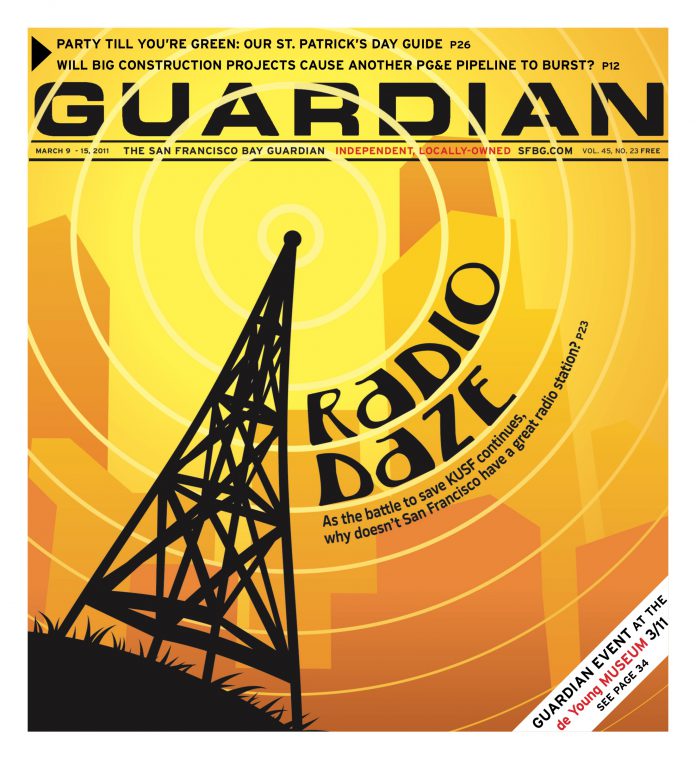DANCE Looking at the magnificent and elegant Merce Cunningham dancers perform Pond Way (1998), Antic Meet (1958) and Sounddance (1975) in the by no means sold-out Zellerbach Hall on March 3 made me sad. Each of these works showed such skill, beauty, and intelligence. Yet they left me pessimistic about the future of a precious repertoire.
So this was it. This was end of the Merce Cunningham Dance Company, which has appeared at UC Berkeley since 1962. Some people there this past weekend have been watching them since year one. I am not one of them. It took me a quite while to realize the difference between “connection” and “coexistence” of movement, music, and design. But I finally understood that connections happened between these elements — not as a result of planning, but simply by together at a particular moment. And once I apprehended Cunningham’s multifocused — rather than front- and center-oriented — stage picture, a wondrous world opened up.
Now it’s finished. Shortly before his death, the choreographer decided the company would go on a two-year “Legacy Tour” around the world and then disband. Following the Balanchine model, Cunningham set up a foundation that can license the pieces to companies that want to perform them. That’s the rub.
Who can do them? The company’s early quintets or septets are one thing, but his big, companywide choreographies, which still don’t make for easy viewing, are another. We don’t have a tradition of repertory modern dance companies; they are driven by their founder-choreographers. So who can do justice to Cunningham?
Ballet companies would seem the logical choice, since Cunningham’s technique — though exceedingly specific — relies heavily on ballet-trained dancers. But would these ensembles invest the amount of rehearsal that a Cunningham piece would require, especially at a time when choreographers are given as little as two weeks to create a new piece on a company? And what about their conservative base of support?
The serenely lyrical Pond Way has been described as one of Cunningham’s nature pieces. To be sure, Brian Eno’s sound score includes some howling monkeys and barking dogs, and if you want, you can see loping gazelles and hoping frogs in the choreography. But the work, with the ensemble dressed by Suzanne Gallo in tunic-like tops and wide pants, suggests a crowded Elysian fields — assuming one knows what that looks like — where the inhabitants are engaged in some kind of praise dancing.
Maybe Roy Lichtenstein’s barely perceivable ship on the backdrop had brought them there. Brandon Collwes, his hair bleached the whitest of blonds, magisterially streaked through the unisons, only to join them. An upstage quintet for women seemed inspired by Greek vase paintings. And then there was Marcie Munnerly, who for the longest period stood frozen in a running position, oblivious to the guys who tried to get her attention. She finally whipped herself into a solo that pulled her into the wings.
The recently-reconstructed Antic Meet, with Robert Rauschenberg’s design, is a rarity. A mashup of vaudeville and silent movie pratfalls, it’s a full-blown comedy. It takes on the oh-so-serious attempts of (old school) modern dancers to squeeze meaning out of every gesture. The dancers strained, pushed, pulled, then hopelessly collapsed into a muddle. Four of them, dressed in fluttering parachutes, flopped and hopped and surrounded their “heroine.” They looked as much like Edward Gorey characters as Martha Graham acolytes. Curiously, John Cage’s score sounded very much of its time, but the wittily-danced choreography looked as fresh as ever.
In this context, the sweet Sounddance felt like a farewell. Robert Swinston, the ensemble’s rehearsal director and a company member since 1980, stepped into the Cunningham role. As heavy baroque curtains seemed to spit out the dancers one by one, he tried to keep an eye on the multiple actions — four men manipulating Andrea Weber; evanescent couples and line dancing; Rashaun Mitchell enclosing everyone in a magic circle. In the end, the dancers and Swinston/Cunningham disappeared back into the curtains. It seemed very final.

